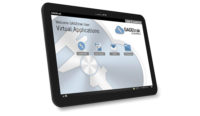Calibrations in the Cloud

Cloud computing has been an IT buzz word for several years. It is now mainstream. Calibration management software is no exception in the trend to move business application software to the cloud.
Many people have probably heard of cloud computing. In fact, most people use cloud computing whether they realize it or not. If you are using Internet search engines; Web-based e-mail such as Yahoo, Hotmail and Gmail; social networking systems such as Facebook and Twitter; or even online banking, then you are already using cloud computing.
Let’s take a closer look at cloud computing, how it applies to calibration management software and why it is relevant, as well as examine some of the major benefits and risks of this emerging technology.
What is Cloud Computing? The term cloud is just a metaphor for the Internet, which is typically drawn as a cloud shape on network diagrams. Cloud computing providers deliver various business software applications, which are most often accessed from a Web browser. The main distinction of cloud computing vs. traditional computing is that the software, data and computer processing reside on a service provider’s servers.
This is really just Internet-based use of computer technology. The technical details are masked from the users who no longer need to have expertise in the technology that supports them.
In traditional software applications, the user needs to care about what operating system the application will require and hardware requirements such as hard drive space, CPU speed and RAM. He also needs to care about the database system it requires to store his records, such as SQL Server, Oracle and DB2.
Cloud computing is a newer delivery model for IT services and software that usually involves scalable and virtualized resources as a service over the Internet.
Much like the electric service, it can be scaled to accommodate whatever the user needs, and the provider uses whatever resources-such as coal, solar, nuclear or wind-to generate the electricity. The consumer does not need to know the technical details-he just wants his lights to go when he flicks the switch.
Moving Calibrations to the Cloud
While there are only a handful of companies currently offering calibration management software systems that can be run through a Web-browser, there are still fewer that provide this software as a service (SaaS) through cloud computing. One of the reasons for the lack of choice is the lack of need.
In a typical medium-sized manufacturing facility there are perhaps only one or two technicians who use calibration management software. In a larger facility there may be five to 20 users. It is not too difficult or costly to set up and maintain traditional desktop software for so few users.
Compared to enterprise resource planning (ERP) and customer relationship management (CRM) software, which may have a hundred or more users in a medium-sized facility, the value proposition for cloud computing is significant since there are so many users.
The effort and costs to deploy, manage and maintain desktop-based software for so many users are huge. As a result, there are many competitive choices now available for ERP and CRM cloud computing. It is no wonder that an enterprise cloud computing company such as Salesforce.com generates close to $1.5 billion annually on its CRM system. Software giants such as IBM, Oracle and Microsoft have taken notice and all have offerings for cloud computing. They know where this is trending.
In the field of quality assurance and control, there are some cloud and Web-based management systems for statistical process control (SPC), document control, failure mode and effects analysis (FMEA), and corrective actions. But again, the choices are few at present. This will change in the coming months and years as the market learns about the benefits of cloud computing and demands that traditional desktop software be moved to the cloud.
As for calibration management software, a few vendors were early to market with Web-based software and have been offering solutions for more than a decade. Though market demand was initially low, there has been a slow, steady increase in demand over the years for calibration software that runs through a Web browser.
One popular package initially included Web modules that would front-end the desktop software mostly for reporting. Later on, other modules were developed for entering calibration data through a Web browser and for creating aggregated reports across multiple facilities.
Yet, in most cases, customers host their software and databases locally on their internal networks and run the Web-based modules over their own intranets.
In the past couple of years, some larger clients, particularly those with many facilities and users, have completely shifted their calibration system to the cloud by having the provider host both their software and data.
For better security, they typically access their software through the Internet using a secure connection that encrypts all incoming and outgoing data with secure sockets layer (SSL). Their IT departments are quite happy since there are no servers to buy and set up, no deployment efforts-other than sending an e-mail to the users with the link and logon credentials-and no maintenance is required because the provider takes care of their database backups and software updates.
Software users also are happy since they can access their software from any computer that is convenient, receive automatic updates without IT involvement and can lookup information while on the road.
Cloud computing also supports easy set up of remote-access accounts for calibration service providers to enter measurement data and calibration certificates for their clients.
Pros and Cons
There are many good reasons to go with a cloud computing software application. Some reasons to consider using them include:
Cost Efficient. The service provider will host services for multiple companies. Sharing complex infrastructure is cost-efficient and the user only pays for the services he actually uses.
Fast Deployment. The most basic cloud services work out of the box and can be ready to use in just a few hours or a few days. For more complex software and database solutions, cloud computing allows for skipping the hardware procurement and capital expenditure phase-it is perfect for new facility start-ups, those with limited IT budgets and organizations without in-house IT expertise. If roll-out to multiple facilities is needed, going with cloud solutions is a compelling option.
No Maintenance. Most providers constantly update their software offerings, adding new features and software patches as soon as they become available.
Highly Scalable. If a business is growing or has seasonal spikes, it can scale up quickly because cloud systems are built to cope with sharp increases in workload and in the number of users. On the other hand, it is just as easy to scale down when services are no longer needed.
Mobile. Cloud services are designed to be used from a distance, so if a company has a mobile workforce, its staff will have on-the-go access to its systems.
Cloud computing also has raised some concerns. Providers are well aware of these and continue to find ways to eliminate risks and reduce these concerns. Some of the top concerns include:
Customizing Expenses. While traditional applications have many features to cope with specialized needs, customizing a cloud service typically costs more. However, most providers are able to roll-out newly developed features to all customers much more quickly than traditional application software vendors.
Usability. Usability is an issue. Some people are firmly tied to their existing traditional software. They are reluctant to switch to plainer online applications that may not have all of the user interface features and functions to which they are accustomed. Although providers are somewhat hampered by limitations of the browser, efforts are constantly being made to bring parity between traditional and cloud application software.
One example is shifting some of the user-interface processing to the user’s local computer (client side) so the application is more responsive. The use of Asynchronous JavaScript and XML (AJAX), Adobe Flex and Microsoft Silverlight are examples of technologies that improve usability and provide a richer desktop-like experience to users of Web-based and cloud applications.
Connectivity. Connectivity is another worry. Users of cloud systems must have the proper Internet bandwidth and connection reliability in order to fully utilize the system. That is not to say that all problems are on the user side. Sometimes cloud services do fail and go down, but this is rare due to redundancy and failover systems. However, most problems are rooted more in the client organization’s internal network.
Security. Security concerns are a big issue. Customers need to know that their data will be safe and protected. In some cases, there are legal compliance requirements-such as those for finance, human resources and healthcare applications-and also regulatory issues such as for medical, pharmaceutical and defense industry manufacturers.
For business security, there is the concentration of corporate risk in one single place. If a company is running its CRM in the cloud, it certainly does not want competitors gaining access to its customer database. Likewise, it does not want competitors gaining access to proprietary formulas, process setups and capacity information stored in an ERP system.
Providers of cloud services have multiple lines of redundancy, multiple layers of defense and multiple levels of security that a single company usually could not afford on its own.
While larger business software applications such as CRM and ERP already have moved to the cloud for reasons of cost efficiency, reduced maintenance costs, centralized management and easier deployment, smaller and more specialized software applications such as calibration management also are making the move for many of the same reasons.
For organizations looking to upgrade or replace their current calibration system, cloud computing is an option worth investigating for its potential benefits.
Quality Online
For more information of calibration software, visit www.qualitymag.com to read the following:
“Calibration Made Simple”
“Successful Software Selection”
Looking for a reprint of this article?
From high-res PDFs to custom plaques, order your copy today!




